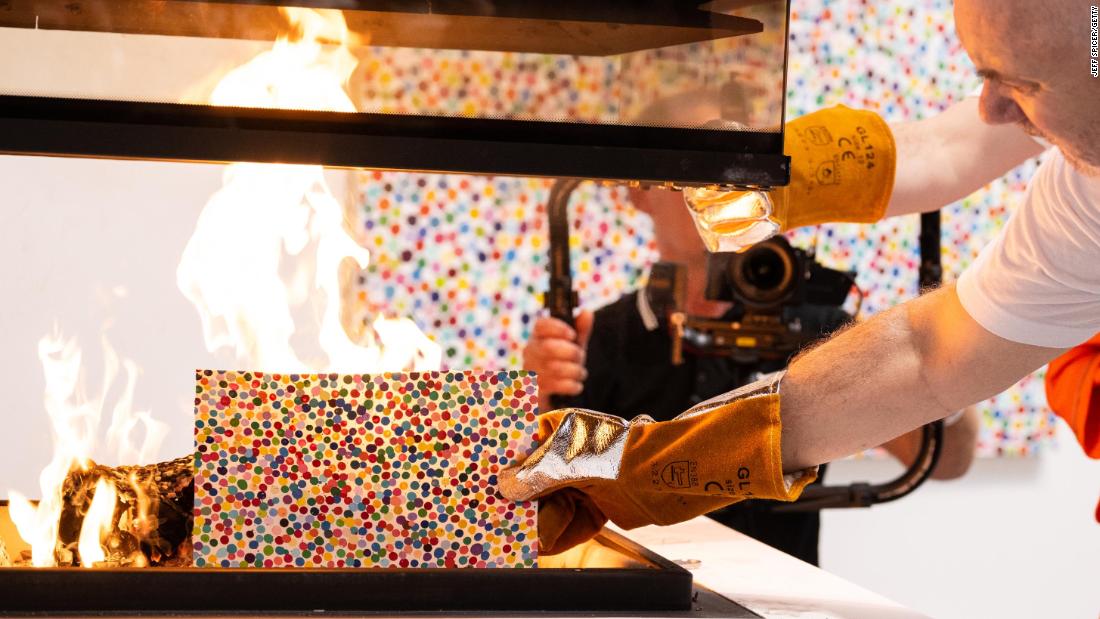
Smoke rose from artist Damien Hirst’s London gallery on Tuesday, as 1,000 of his signature “spot” paintings went up in flames. Thousands more will be reduced to ashes before the month is out.
This was no accident, however. The entire second floor of the two-story Newport Street Gallery was filled with a bonfire-like odor as journalists and camera crews crowded in to watch 57-year-old Hirst feed painting after painting into six glass-cased incinerators as part of his latest commentary on the value of art and the forces that dictate it.
The livestreamed event — beamed onto screens in the gallery foyer as well as on Instagram — was part of Hirst’s project “The Currency,” which began six years ago with the creation of 10,000 unique dotted paintings. Rather than selling the works, the British artist stored them in a vault and instead offered collectors a chance to purchase one of 10,000 corresponding NFTs.
He then gave buyers a choice: trade in their digital token for the physical painting it represents, or allow the artwork to burn. Owners of 4,851 of them chose the latter.
At Tuesday’s event, held the day before the Frieze London art fair, the exhibition space — with its long central workbench, the gallery assistants dressed in matching orange jumpsuits, and Hirst in a pair of silver trousers held up by braces — resembled a Santa’s workshop of destruction. Despite the somber connotations of art-burning, the artist was jovial while destroying his work — smiling, making faces and chatting with journalists packed into the press corner.
Although Hirst refused interviews beforehand, he happily fielded questions from behind the barrier: “To me there’s no gamble,” he said when asked about the value of NFTs over physical works, “there’s only ever art.”

Damien Hirst began burning thousands of his own artworks at London’s Newport Street Gallery on Tuesday October 11. Credit: Jeff Spicer/Getty
A question of value
Produced in 2016, the original paintings were all signed, numbered and given unique titles. (Names were created by applying machine learning to some of Hirst’s favorite song lyrics, resulting in titles like “Never getting up” and “Since making love in love.”) No two works are identical, and no two dots in a single painting are the same color.
Each artwork was then linked to an NFT, a blockchain-backed digital token that can be bought and sold. Last summer, successful applicants were allocated a random token for $2,000 each.
In July, after a year of trading, owners were able to “redeem” their NFTs. Most of the 5,149 collectors who opted to trade in their tokens have now been sent the paintings. The rest of the physical artworks will be burned at Hirst’s private gallery between now and the end of October.
Those incinerated on Tuesday, in fact, belong to the artist (he held back 1,000 out of the 10,000 for himself). After his deadline passed in July, Hirst wrote on Twitter that deciding what to do with his portion of the works had left his “head in a spin.”
He also grappled with the question underpinning the project: Will the physical or digital versions be worth more?

A total of 4,851 original paintings from “The Currency” will be destroyed while their twin NFTs remain. Credit: Prudence Cuming
Playing with fire
Hirst is, along with Tracey Emin, considered a key member of the Young British Artists movement that emerged in London in the 1980s. He has (or, often, his assistants have) been making his characteristic spot paintings for more than three decades. The paintings’ colored dots vary in density, shade and neatness, making them at once unique and almost indistinguishable from one another.
The artist’s work often addresses — and, due to the amount it can sell for, raises — questions about money in the art world. One of his best-known works is a platinum cast of a human skull, covered with more than 8,600 diamonds, that sold for a reported £50 million (then around $100 million) in 2007.
“The whole thing is the artwork,” he explained at the time. “It’s almost like the behavior of the human beings that are all involved in it … it just will have a life of its own.”
